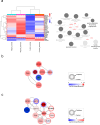Proteomic analysis of CD29+ Müller cells reveals metabolic reprogramming in rabbit myopia model
- PMID: 39402218
- PMCID: PMC11473955
- DOI: 10.1038/s41598-024-75637-1
Proteomic analysis of CD29+ Müller cells reveals metabolic reprogramming in rabbit myopia model
Abstract
The prevalence of myopia is rapidly increasing, significantly impacting the quality of life of affected individuals. Prior research by our group revealed reactive gliosis in Müller cells within myopic retina, prompting further investigation of their role in myopia, which remains unclear. In this study, we analyzed protein expression changes in CD29+ Müller cells isolated from a form deprivation-induced rabbit model of myopia using magnetic activated cell sorting to investigate the role of these cells in myopia. As the principal glial cells in the retina, Müller cells exhibited significant alterations in the components of metabolic pathways, particularly glycolysis and angiogenesis, including the upregulation of glycolytic enzymes, such as lactate dehydrogenase A and pyruvate kinase, implicated in the adaptation to increased metabolic demands under myopic stress. Additionally, a decrease in the expression of proteins associated with oxygen transport suggested enhanced vulnerability to oxidative stress. These findings highlight the proactive role of CD29+ Müller cells in modifying the retinal environment in response to myopic stress and provide valuable insights into mechanisms that could help mitigate myopia progression.
Keywords: Glycolysis; Myopia; Müller cells; Oxidative stress; Proteomics.
© 2024. The Author(s).
Conflict of interest statement
The authors declare no competing interests.
Figures





Similar articles
-
Laser capture microdissection-directed profiling of glycolytic and mTOR pathways in areas of selectively ablated Müller cells in the murine retina.Invest Ophthalmol Vis Sci. 2013 Oct 9;54(10):6578-85. doi: 10.1167/iovs.13-12311. Invest Ophthalmol Vis Sci. 2013. PMID: 23982838
-
Retinal Proteome Analysis Reveals a Region-Specific Change in the Rabbit Myopia Model.Int J Mol Sci. 2023 Jan 9;24(2):1286. doi: 10.3390/ijms24021286. Int J Mol Sci. 2023. PMID: 36674802 Free PMC article.
-
The Proteome of Native Adult Müller Glial Cells From Murine Retina.Mol Cell Proteomics. 2016 Feb;15(2):462-80. doi: 10.1074/mcp.M115.052183. Epub 2015 Aug 31. Mol Cell Proteomics. 2016. PMID: 26324419 Free PMC article.
-
Insights on the Regeneration Potential of Müller Glia in the Mammalian Retina.Cells. 2021 Jul 31;10(8):1957. doi: 10.3390/cells10081957. Cells. 2021. PMID: 34440726 Free PMC article. Review.
-
Müller glial cell reprogramming and retina regeneration.Nat Rev Neurosci. 2014 Jul;15(7):431-42. doi: 10.1038/nrn3723. Epub 2014 Jun 4. Nat Rev Neurosci. 2014. PMID: 24894585 Free PMC article. Review.
Cited by
-
Understanding amblyopia from the perspective of neurovascular units: changes in the retina and brain.Front Cell Dev Biol. 2025 Jun 27;13:1590009. doi: 10.3389/fcell.2025.1590009. eCollection 2025. Front Cell Dev Biol. 2025. PMID: 40655949 Free PMC article. Review.
References
-
- Holden, B. A. et al. Global prevalence of myopia and high myopia and temporal trends from 2000 through 2050. Ophthalmology. 123, 1036–1042. 10.1016/j.ophtha.2016.01.006 (2016). - PubMed
-
- Yu, Q. et al. Association between inflammatory cytokines and oxidative stress levels in aqueous humor with axial length in human myopia. Exp. Eye Res. 237, 109670. 10.1016/j.exer.2023.109670 (2023). - PubMed
MeSH terms
Grants and funding
LinkOut - more resources
Full Text Sources
Research Materials

